
Publisert: 01.09.23 av Anders Medhus
Lesetid: 9min.

From wandering in Longyearbyen and the journey to a brand
The beginning of Kantefølflak, part 1.
Everything has its story. Take, for example, iceberg lettuce, oranges, and potatoes. They all arrived in Norway under different circumstances at different times. It is reportedly thanks to Theo Holm and McDonald's that iceberg lettuce was introduced here in 1988. Oranges gained traction when Herman Hansen saw the business potential in the new fruit. The potato came to Norway with soldiers, traders, and priests who had studied in Copenhagen.
The potato’s history – specifically the shift from "Kartoffel" to "Kanteføl" – was the fascination and inspiration, for building a new brand: Kantefølflak.
First, a bit about this blog. The goal of the Fjelltid blog is to share insights that we at Kantefølflak AS hope will be entertaining – perhaps even inspiring – as you discover flakes of Kanteføl, fried in small batches and seasoned. Naturally crispy.
The idea of Kantefølflak
Early one Saturday morning in April 2016, seven thirsty men from Hallingdal wandered from Carlsberger pub to Svalbar pub in Svalbard. Jan, one of the guys, expressed a craving for something salty to snack on.
In silence, between Carlsberger and Svalbar, I sent a message to my father, who at the time was the editor of Radio Hallingdal. I asked if he remembered the distinctive dialect word for potato in Hallingdal. After all, someone in the group was craving something salty, and it seemed a solution was needed quickly. A one-word SMS quickly arrived: "Kanteføl".

Inside Svalbar pub, slightly tipsy as we all were, I said to the group: "When I get home, I'm going to make Kantefølflak." They dismissed it as a drunken idea, but a seed was planted. I started thinking about and discussing investment opportunities. The idea of Kantefølflak began to take shape.
From idea to action
Back home from Svalbard, my father was – coincidentally – proofreading a book about the Hamarsbøen sheriff’s family in Hol. He handed me a note with a quote from the book "Brev Heim, by Torstein Seim". It was a footnote about Ola Hamarsbøen’s discovery of "Kartoffel" in Ulvik, which by 1760 had become "Kanteføl" in Hol in Hallingdal. "That’s why we say Kanteføl in Hallingdal," he pointed out.
This little story fascinated me so much that I was inspired to put on my entrepreneur hat. I wanted to build a new, possibly strong brand in the snacks category in Norway.
Elevator pitch and StartUpp
The first flakes were made in the kitchen of Kent Artzen at Hallingdal Catering on Torpomoen. It was Kent who first believed that Brunost chips would be a winner. We used potatoes from the store and spices that I had made at home, using brown goat cheese from Prestholt Geitost.
At the time, I was working for Hallingdal Hytteservice as a marketing manager. My boss and colleague at the time, Stian Oland, introduced me to the concept of an "elevator pitch" when I mentioned the idea of the flakes. He helped me with the pitch. To be precise, he tore it apart and told me to start over. The pitch was later used in the StartUpp Hallingdal competition (2017) and in pitches to chain offices, producers, suppliers, etc.
See pitch #1 from StartUpp Hallingdal, here:
Photo: Stian Oland
The demand for Kantefølflak started to grow. My own need was to show family and friends that it could be done, and those who listened and tasted the samples developed a growing need to taste more. Kantefølflak had to be produced on some scale.
Hard work and coincidences
Giving up was never an option. I may be wrong, but I believe it’s typical for entrepreneurs to lack the ability to quit. Why stop at the first and best peak when the view is a little better, a little higher up? Of course, some coincidences are needed to succeed, but not luck. Another thing I learned was that "luck" is just the result of hard work and coincidences.
There were (and are) many coincidences. From the conception of the idea to the first commercial production of Kantefølflak, I noted 86 small and large achievements. Several of these fall under the category of "coincidence".
For example, my niece had a group project in the spring of 2017 – completely by chance – on "The Journey of the Potato from Soil to Store as Potato Chips". After reading their presentation, I learned that a specific potato variety was used for potato chips.
Curious as I was (and am), I turned over a bag of potato chips in the store to see who the producer was. I contacted a potato producer at Ruud farm before I even started the car on my way out of the parking lot. I was met with an open mind and got my first seed potatoes, of the right type for chip production (Lady Claire).
Although the project started at the wrong end (branding before prototype), it was important to me to do as much as possible by the book. Late in the fall of 2017, the Norwegian Industrial Property Office fortunately agreed with me. Kantefølflak was approved as a registered trademark for potato chips in Norway. Norway's third registered trademark in the snacks category.
Production on a micro scale
The winter of 2017 and 2018 was spent producing flakes in the home kitchen using real chip potatoes. Micro scale. I had neither the expertise nor enough capital to build my own factory. Additionally, I spent time creating contacts with players (producers) for possible collaborations and reaching out to stores (chain offices) to explore potential opportunities for entering the market with Norway's third registered trademark for potato chips, as Norway's fourth player in the potato chips snack segment. Everyone I scheduled a meeting with signed an NDA (non-disclosure agreement) stating that they could not proceed with ideas, the trademark, or flavor(!) unless I was involved.
After a long winter of trial and error, emails, phone calls, waiting, various presentations, home production, and relevant meetings: The first seed potato (from Ruud farm) was planted in my small 3-square-meter kitchen garden in the spring of 2018.
The big question in 2018 was whether I could build my own small microchips factory in Hol if I didn't hear back from the one producer who had shown the most interest in a collaboration.
Despite the waiting and all the unanswered questions, I got a nice little harvest of 2 to 3 kilos of chip potatoes from my garden—just enough yield for about 20 containers of 50g potato chips. This became the foundation for 'Vipps4Chips.' (Vipps is a Norwegian banking solution for easy and small money transfers, widely known and frequently used).
Vipps4Chips
After a summer filled with motorcycle trips to various historical sites related to the history of the potato, I was able to harvest my own chip potatoes and produce a few small batches of Kantefølflak, served in my own containers with the first Kantefølflak design. The first sales channel was found and successfully tested.

Left image: On October 5, 2018, Ostebygda hosted a "Yst og Tyst," a concept where beer from Kinn is paired with cheeses from Ostebygda. Kantefølflak was part of the experience as a supplier and partner. Here, Kinn’s founder, Espen Lothe, got to taste Kantefølflak with brunost.
Right images: From the Autumn Market in Hol. Visitors could purchase pre-ordered containers of 50g Kantefølflak along with a t-shirt featuring the logo. The "Vipps4Chips" concept (sporadically) continues today, with Hallingmarken 2023 as the latest example. 240 bags in 3 days. We still operate on a small scale.
Further growth
The local newspaper Hallingdølen has been (and still is) a great supporter. They have followed the development and written award-winning articles about the product. You can find the articles at hallingdolen.no. Search for "Kantefølflak".
Together with local press and good friends in a small village, a lot of optimism quickly built up around the concept of Kantefølflak. Supporters who cheer for the concept, the fascination with the story, and not least, the taste of Kantefølflak.
In terms of sales, we can sum up the first entrepreneurial years with networking, micro-scale production for local markets, and strong supporters who saw that Kantefølflak had a right to exist.
New opportunities for Kantefølflak
It’s late in the fall of 2018. The days are flying by with work tasks. The air is fresh outside, and the mountains are calling. I’m sitting in the office. I have just received a final (and brutal) "no" from a Norwegian potato chip producer after patiently waiting for a proper response. They don’t have the capacity. They call it potential cannibalism if they were to make another brand under the same roof. Afraid of competition? I think so.
The days pass. A Danish producer suggests production in Denmark. Should I then import Kantefølflak from the country where they still call the potato "Kartoffel"? And then distribute it to selected stores myself? Maybe. In that case, I would have gotten my wish – to get Kantefølflak into stores, in some scale.
The weeks go by. A new phone call comes. The future factory manager tells me about their plans to build a new, small chip factory in Norway. He’s curious about what "Kanteføl" is and wonders if it has anything to do with "ditch fill". Kanteføl, ditch fill, ditch fill. Well, it was a good icebreaker, at least.
The brand-new players in the market had heard about the "Kantefølflak project," and from an unexpected source for me. What was clear was that all the networking efforts were starting to show clear results.
Next, I’m invited to a meeting to discuss Kantefølflak and to see the construction site where the new factory will be built. Fall turns to winter, which turns to spring – naturally. Suddenly, I find myself at the opening of a brand-new chip factory where Erna Solberg cuts the ribbon. Cautiously optimistic, I start to believe that production of Kantefølflak might actually happen. Maybe.
An already long story, shortened a bit more
The first production of Kantefølflak saw the light of day on October 1st and 2nd, 2019. With hearing protection on, I listened to NRK P2 while working on sorting flakes on the conveyor belt in the factory. On the second day of production, NRK coincidentally had a segment about Potato Day.

Publisert: 01.09.23 av Anders Medhus
Lesetid: 9min.
